Gene Therapy Market Size, 2030
The global Gene Therapy Market Size was valued at $6.0 billion in 2020 and is projected to reach $46.5 billion by 2030, growing at a CAGR of 22.8% from 2021 to 2030. Increase in healthcare expenditure, the presence of advanced healthcare infrastructure, availability of reimbursements provide gene therapy market opportunity. However, the high cost of gene therapies is expected to hamper the market growth to a certain extent during the forecast period.
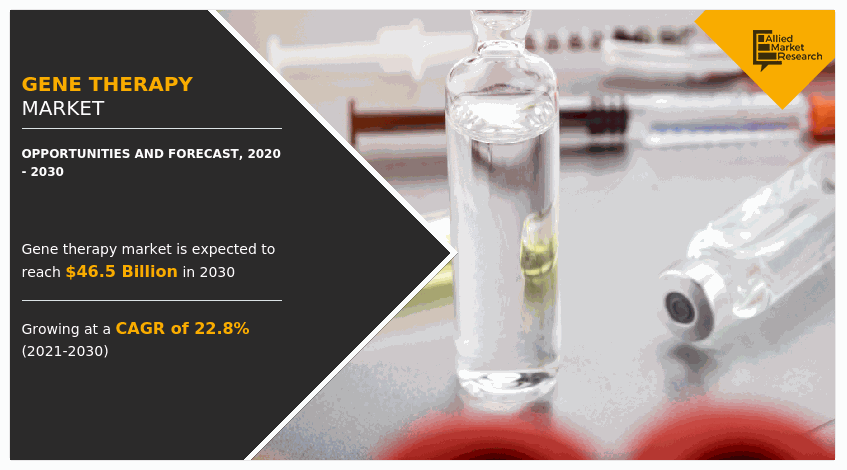
Gene is a functional hereditary unit of life that carries a set of instructions for a particular function. Gene therapy is the advanced treatment applied for cancer, chronic disease, infectious disease, and blood disorders. Gene therapy involves the partial or full replacement of defective genes in a patient's body with healthy ones to treat or prevent disease proliferation. There are two types of gene therapy based on the location of the target gene on a chromosome including somatic gene therapy & germline gene therapy. It can be applied for the treatment of several diseases, such as Parkinson’s, hemophilia, cystic fibrosis, Alzheimer’s, brain tumors, cancer, AIDS, SCID, and others.
The transgene is transferred into the host cell by biological vectors, such as the virus, liposome, and plasmids. These vectors are further categorized as viral vectors & non-viral vectors. The viral vector consists of retrovirus, lentivirus, adenovirus, and adeno-associated vector. The non-viral vector includes liposomes, transposons, and plasmids. The physical methods are also available for gene transfer, such as electroporation, sonication, gene gun, and photoporation.
Market Dynamics
The key factor that drives the Gene Therapy Market Growth is an increase in the prevalence of chronic disorders such as cancer, rare disease genetic disorders, and others globally. In addition, an increase in government support, ethical acceptance of gene therapy for cancer treatment, and a rise in the prevalence of cancer fuel the growth of the market.
Segments Overview
The gene therapy market is segmented on the basis of vector type, gene type, application, and region. On the basis of vector type, it is bifurcated into viral and non-viral vectors. The viral vector segment is further segmented into retroviruses, lentiviruses, adenoviruses, adeno-associated viruses, herpes simplex viruses, poxvirus, vaccinia viruses, and others. The non-viral vector segment is further categorized into naked/plasmid vectors, gene gun, electroporation, lipofection, and others. By therapy type, the market is classified into ex vivo therapy and in vivo therapy.
By gene type, the market is classified into antigen, cytokine, tumor suppressor, suicide, deficiency, growth factors, receptors, and others. By application, it is divided into oncological disorders, rare diseases, neurological disorders, and other diseases. Region-wise, it is analyzed across North America, Europe, Asia-Pacific, and LAMEA.
By Vector Type
By vector type, the gene therapy market is bifurcated into viral and non-viral vectors. The viral vector segment is further segmented into retroviruses, lentiviruses, adenoviruses, adeno-associated viruses, herpes simplex viruses, poxvirus, vaccinia viruses, and others. The non-viral vector segment is further categorized into naked/plasmid vectors, gene gun, electroporation, lipofection, and others.
The non-viral vector segment holds the largest Gene Therapy Market Size and is estimated to witness the highest CAGR during the forecast period. Owing to the rise in the incidence of cancer and other target diseases, the availability of reimbursements policies, and the increase in funding for gene therapy research are the key factors anticipating the growth of the market in upcoming years.
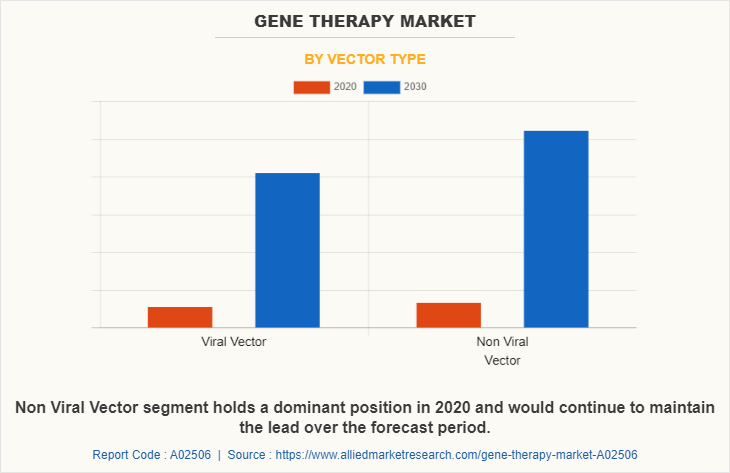
By Therapy Type
By therapy type, the market is classified into ex vivo therapy and in vivo therapy. The in vivo therapy segment held the largest market share in 2020. An increase in the adoption of in vivo gene therapies globally is expected to drive the growth of the market in the future
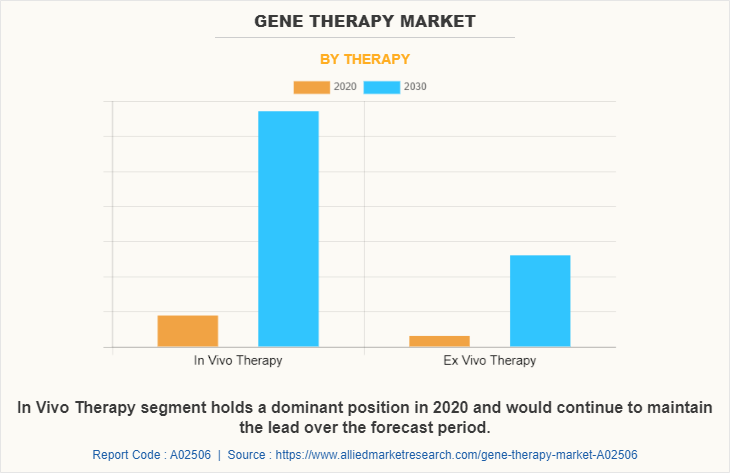
By Gene Type
By gene type, the market is classified into antigen, cytokine, tumor suppressor, suicide, deficiency, growth factors, receptors, and others. The antigen segment held the largest market share in 2020. An increase in the prevalence of autoimmune diseases, cancer, and R&D in antigen-based gene therapies are key factors anticipated to drive the growth of the market in upcoming years.
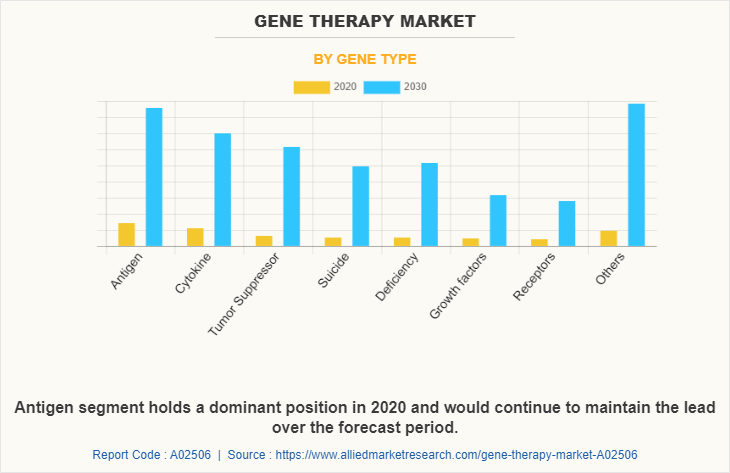
By Application
By application, the Gene Therapy Industry is categorized into oncological disorders, rare diseases, cardiovascular diseases, neurological disorders, infectious diseases, and other diseases. The oncological disorders segment has highest Gene Therapy Market Share. The availability of many gene therapy products that can be used to treat cancer and a large patient population base is expected to drive the growth of the market in upcoming years.
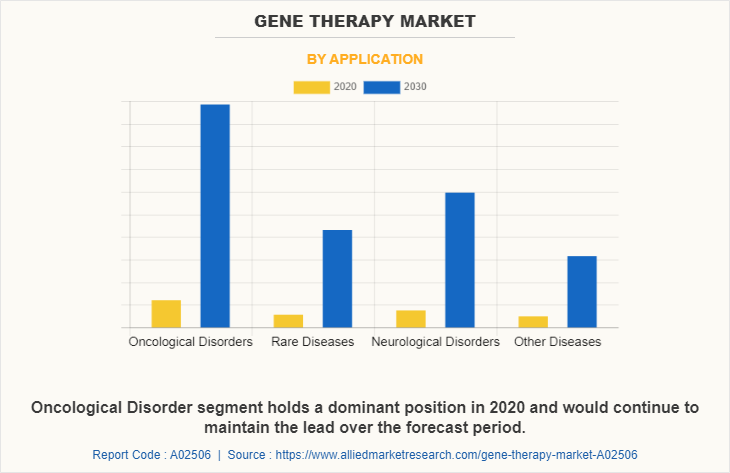
Regional Analysis
By region, the Gene Therapy Market Analysis is done across North America, Europe, Asia-Pacific, and LAMEA. North America was the highest Gene Therapy Market Share in 2020. Owing to the rise in prevalence of chronic diseases, high and growing healthcare expenditure, presence of advanced healthcare infrastructure, availability of reimbursements, and the presence of major market players, the gene therapy market in North America is expected to grow during the forecast period.
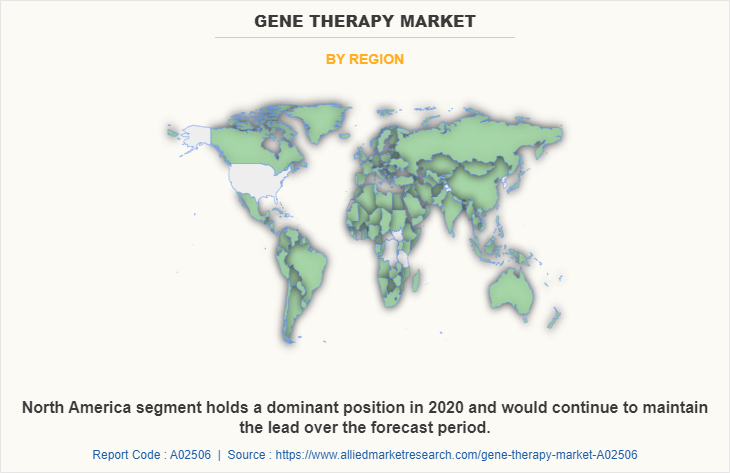
The key players operating in the global Gene Therapy Industry include Novartis AG, Gilead Sciences., Jazz Pharmaceuticals, Orchard Therapeutics., Bristol-Myers Squibb., Amgen Inc., Shenzhen SiBiono Genentech, Shanghai Sunway Biotech Co., Ltd., Adaptimmune Therapeutics plc, Adverum Biotechnologies, Inc., Abeona Therapeutics Inc., Applied Genetic Technologies Corporation, Amgen Inc., Astellas Therapeutics, Inc., Bluebird Bio, Inc., CRISPR Therapeutics AG, Intellia Therapeutics, Inc., REGENXBIO Inc., Sangamo Therapeutics, Inc., Unique N. V., Voyager Therapeutics, Inc., Merck and Co Inc., and Dendron Corporation.
Key Benefits for Stakeholders
- This report provides a quantitative analysis of the market segments, current trends, estimations, and dynamics of the gene therapy market analysis from 2020 to 2030 to identify the prevailing gene therapy market opportunities.
- The market research is offered along with information related to key drivers, restraints, and opportunities.
- Porter's five forces analysis highlights the potency of buyers and suppliers to enable stakeholders make profit-oriented business decisions and strengthen their supplier-buyer network.
- In-depth analysis of the gene therapy market segmentation assists to determine the prevailing market opportunities.
- Major countries in each region are mapped according to their revenue contribution to the global market.
- Market player positioning facilitates benchmarking and provides a clear understanding of the present position of the market players.
- The report includes the analysis of the regional as well as global gene therapy market trends, key players, market segments, application areas, and market growth strategies.
Gene Therapy Market Report Highlights
| Aspects | Details |
| By Vector Type |
|
| By Therapy |
|
| By Gene Type |
|
| By Application |
|
| By Region |
|
| Key Market Players | Amgen Inc., Sangamo Therapeutics, Inc., Abeona Therapeutics Inc., Applied Genetic Technologies Corporation, Bluebird Bio, Inc., Orchard Therapeutics., Dendron Corporation, Novartis AG, Gilead Sciences., Intellia Therapeutics, Inc., Adaptimmune Therapeutics plc, CRISPR Therapeutics AG, Uniqure N. V., Voyager Therapeutics, Inc., Adverum Biotechnologies Inc., Bristol-Myers Squibb., Astellas Therapeutics Inc., Shenzhen SiBiono GeneTech, REGENXBIO Inc., Shanghai Sunway Biotech Co. Ltd., Jazz Pharmaceuticals, Merck and Co Inc. |
Analyst Review
The demand for gene therapy has witnessed rapid growth over the past few years. This is attributed to increasing in technological advancement.
Gene therapies have revolutionized the health sciences and pharmaceutical fields. The number of clinical trials investigating gene therapies increases globally, despite the limited number of products that have successfully been launched in the market. In addition, the benefits of gene therapy over conventional cancer therapies and the increase in government support fuel the growth of the global gene therapy market.
Tumor suppressor and suicide gene therapy are the fastest-growing segments and are expected to provide lucrative opportunities to market players. This therapy involves the introduction of new genes into the tumor cells, which help in destroying the tumor cells without affecting the neighboring healthy cells.
The employment of gene therapy is highest in North America, owing to an increase in investment in R&D activities, the high prevalence rate of cancer, and an increase in disposable income among customers. Although the use of gene therapy in Asia-Pacific and LAMEA is low, the adoption rate is expected to increase due to a rise in disposable income, the high incidence rate of cancer, and government initiative to improve healthcare infrastructure, which in turn drive the market growth.
In 2020, 5,974.17 million is the market value of the Gene Therapy Market
The market value of the Gene Therapy Market report in the forecast period is 46,527.61 million
The upcoming trends in the Gene Therapy Market are an increase in funding for R&D activities pertaining to gene therapy and growth in awareness regarding gene therapy driving the global market growth. In addition, an increase in government support, ethical acceptance of gene therapy for cancer treatment, and a rise in the prevalence of cancer fuel the growth of the market
North America is the largest regional market for Gene Therapy
Novartis AG, Gilead Sciences., Jazz Pharmaceuticals, Orchard Therapeutics., Bristol-Myers Squibb., Amgen Inc., Shenzhen SiBiono Genentech, Shanghai Sunway Biotech Co., Ltd., Adaptimmune Therapeutics plc are the top companies to hold the market share in Gene Therapy
Loading Table Of Content...


